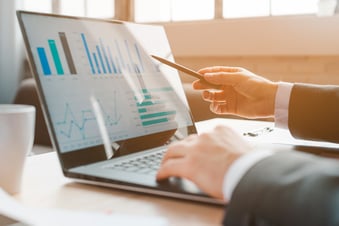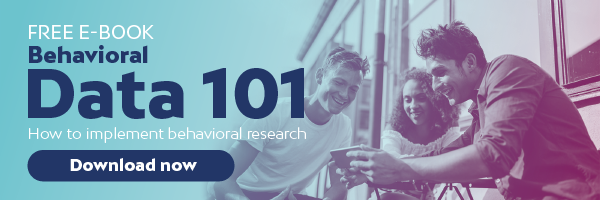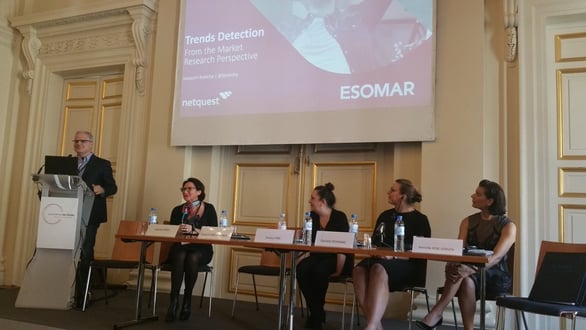At the beginning of every year, the biggest fashion magazines talk about the latest trends for the upcoming seasons. This year, we decided to do the same for market research. For example, we know that in Spring/Summer, we’ll be seeing plenty of Bermuda shorts, mini shorts, and vintage denim. In the same way, since the end of last year, the market research sector has given us a glimpse of what’s to come in “twenty twenty.”
Keep reading to learn what the sector's main trends will be over the course of this year.
1. A timeless classic: ethical data usage
With time, sneakers and running shoes became the go-to complement for jeans. In the same way, ethics have become a must-have when we talk about data.
For a long time, there has been an enormous weight on our shoulders when it comes to using data, since it belongs to real people. After being named president of ESOMAR in 2018, Joaquim Bretcha reflected on this point. In his words: "(the goal) to regulate with very clear ethics, because personal information is sacred."
Today, with technology advancing at exponential rates—and our ability to collect and process data growing along with it—it's more important than ever to recognize that ethical data handling is a necessary accessory.
Read more: Privacy policies:What is the ethics of your online panel?
2. Avant-garde: Automation
 On the topic of technological advances, it's time to talk about automation as one of 2020's most important trends. Let's think for a minute about the boom that sneakers had in 2018, with countless different styles, colors, and shapes available. It was just a matter of time before someone popularized chunky sneakers.
On the topic of technological advances, it's time to talk about automation as one of 2020's most important trends. Let's think for a minute about the boom that sneakers had in 2018, with countless different styles, colors, and shapes available. It was just a matter of time before someone popularized chunky sneakers.
The same is true of automation: it was predictable that this year, we'd be talking about chatbots and the new mobile. Ray Poynter, a member of the ESOMAR Council and founder of #NewMR, says that the biggest trend in 2020 will be applying recent innovations, particularly automation and, to a lesser extent, artificial intelligence (AI), to deliver faster, cheaper, better research.
3. Something a little more intimate: Behavioral data
Everyone knows that behind—or, rather, beneath—every great outfit, there are a few underthings holding everything in place, and that the same garments would look odd with other underwear. Forgive the analogy, but I think it’s justified in the role we can expect behavioral data to play on MR catwalks.
Market research and associated technologies open a lot of new perspectives up to researchers, which means we can measure online behavior with greater precision. Today, we can ask fewer questions and still get a more detailed picture of consumers.
Read more: Infographics: What to look for in behavioral data
4. Haute Couture: Big Data
 On the most refined Haute Couture catwalks, there’s no doubt that the next big trend will be Big Data.
On the most refined Haute Couture catwalks, there’s no doubt that the next big trend will be Big Data.
Big Data will offer an abundance of opportunities to market insight programs, but without trained experts to analyze the results, it’ll be hard for those opportunities to bear any fruit. Haute Couture (“high dressmaking”) means creating garments that are tailor-made to the customer’s taste.
You could say that there’s an equivalence between the artisanal work that a Haute Couture piece requires and the huge amount of labor involved in Big Data. With this innovative approach, data cannot be processed manually; you need to use sophisticated applications for processing large volumes of data. Think of the data scientists as seamstresses embroidering an evening gown, one sequin at a time.
5. On the catwalks: Data visualization
 Last but not least, we have to wonder: What would be the point of putting all this effort into each piece of high-fashion streetwear if there were no catwalks? Catwalks demonstrate the creativity and effort that went into a collection.
Last but not least, we have to wonder: What would be the point of putting all this effort into each piece of high-fashion streetwear if there were no catwalks? Catwalks demonstrate the creativity and effort that went into a collection.
We could also ask: What's the point in gathering data? What are we going to do with it once we have it? Regardless of how much we gather, we need to collect data in such a way that clients can understand it, operate it, and, literally, use it.
We don't gather data without a clear goal in mind; we gather data that provides useful information and adds value. For insight professionals, this requires an understanding of cognitive information systems. As computers get better at gathering data, strong data processing and visualization abilities become even more essential.
Read more: Five advantages of data visalization
And so we conclude this short list of 2020 trends. We know that there's more to cover, and that these won't be the only trends worth discussing this year. Even so, we wanted to talk a little about the ones that we think are the most relevant. Speaking of relevance, we'd like to invite you to download this free e-book on behavioral data. Click on the banner and learn how to utilize this kind of data in your research:






